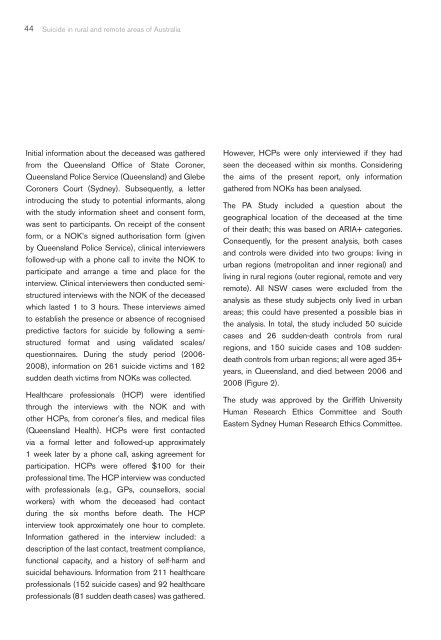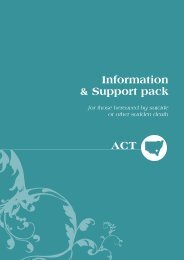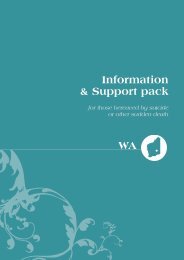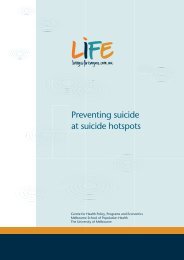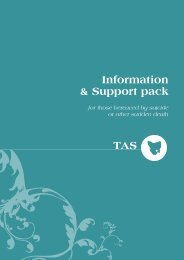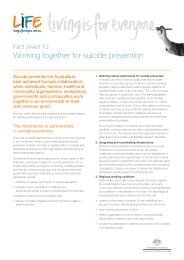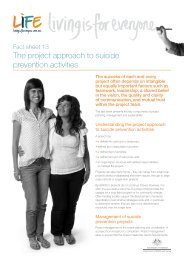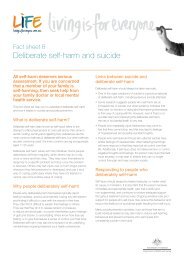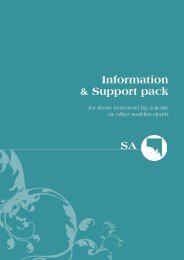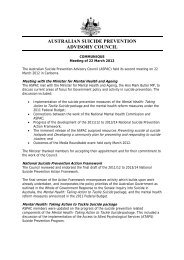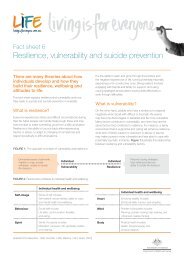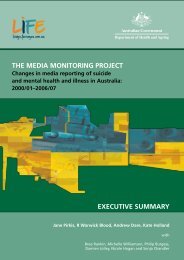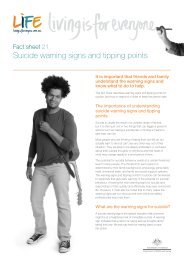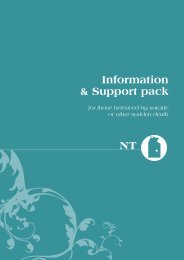SUICIDE in RURAL & REMOTE AREAS of AUSTRALIA - Living is for ...
SUICIDE in RURAL & REMOTE AREAS of AUSTRALIA - Living is for ...
SUICIDE in RURAL & REMOTE AREAS of AUSTRALIA - Living is for ...
Create successful ePaper yourself
Turn your PDF publications into a flip-book with our unique Google optimized e-Paper software.
44<br />
Suicide <strong>in</strong> rural and remote areas <strong>of</strong> Australia<br />
Initial <strong>in</strong><strong>for</strong>mation about the deceased was gathered<br />
from the Queensland Offi ce <strong>of</strong> State Coroner,<br />
Queensland Police Service (Queensland) and Glebe<br />
Coroners Court (Sydney). Subsequently, a letter<br />
<strong>in</strong>troduc<strong>in</strong>g the study to potential <strong>in</strong><strong>for</strong>mants, along<br />
with the study <strong>in</strong><strong>for</strong>mation sheet and consent <strong>for</strong>m,<br />
was sent to participants. On receipt <strong>of</strong> the consent<br />
<strong>for</strong>m, or a NOK’s signed author<strong>is</strong>ation <strong>for</strong>m (given<br />
by Queensland Police Service), cl<strong>in</strong>ical <strong>in</strong>terviewers<br />
followed-up with a phone call to <strong>in</strong>vite the NOK to<br />
participate and arrange a time and place <strong>for</strong> the<br />
<strong>in</strong>terview. Cl<strong>in</strong>ical <strong>in</strong>terviewers then conducted sem<strong>is</strong>tructured<br />
<strong>in</strong>terviews with the NOK <strong>of</strong> the deceased<br />
which lasted 1 to 3 hours. These <strong>in</strong>terviews aimed<br />
to establ<strong>is</strong>h the presence or absence <strong>of</strong> recogn<strong>is</strong>ed<br />
predictive factors <strong>for</strong> suicide by follow<strong>in</strong>g a sem<strong>is</strong>tructured<br />
<strong>for</strong>mat and us<strong>in</strong>g validated scales/<br />
questionnaires. Dur<strong>in</strong>g the study period (2006-<br />
2008), <strong>in</strong><strong>for</strong>mation on 261 suicide victims and 182<br />
sudden death victims from NOKs was collected.<br />
Healthcare pr<strong>of</strong>essionals (HCP) were identifi ed<br />
through the <strong>in</strong>terviews with the NOK and with<br />
other HCPs, from coroner’s fi les, and medical fi les<br />
(Queensland Health). HCPs were fi rst contacted<br />
via a <strong>for</strong>mal letter and followed-up approximately<br />
1 week later by a phone call, ask<strong>in</strong>g agreement <strong>for</strong><br />
participation. HCPs were <strong>of</strong>fered $100 <strong>for</strong> their<br />
pr<strong>of</strong>essional time. The HCP <strong>in</strong>terview was conducted<br />
with pr<strong>of</strong>essionals (e.g., GPs, counsellors, social<br />
workers) with whom the deceased had contact<br />
dur<strong>in</strong>g the six months be<strong>for</strong>e death. The HCP<br />
<strong>in</strong>terview took approximately one hour to complete.<br />
In<strong>for</strong>mation gathered <strong>in</strong> the <strong>in</strong>terview <strong>in</strong>cluded: a<br />
description <strong>of</strong> the last contact, treatment compliance,<br />
functional capacity, and a h<strong>is</strong>tory <strong>of</strong> self-harm and<br />
suicidal behaviours. In<strong>for</strong>mation from 211 healthcare<br />
pr<strong>of</strong>essionals (152 suicide cases) and 92 healthcare<br />
pr<strong>of</strong>essionals (81 sudden death cases) was gathered.<br />
However, HCPs were only <strong>in</strong>terviewed if they had<br />
seen the deceased with<strong>in</strong> six months. Consider<strong>in</strong>g<br />
the aims <strong>of</strong> the present report, only <strong>in</strong><strong>for</strong>mation<br />
gathered from NOKs has been analysed.<br />
The PA Study <strong>in</strong>cluded a question about the<br />
geographical location <strong>of</strong> the deceased at the time<br />
<strong>of</strong> their death; th<strong>is</strong> was based on ARIA+ categories.<br />
Consequently, <strong>for</strong> the present analys<strong>is</strong>, both cases<br />
and controls were divided <strong>in</strong>to two groups: liv<strong>in</strong>g <strong>in</strong><br />
urban regions (metropolitan and <strong>in</strong>ner regional) and<br />
liv<strong>in</strong>g <strong>in</strong> rural regions (outer regional, remote and very<br />
remote). All NSW cases were excluded from the<br />
analys<strong>is</strong> as these study subjects only lived <strong>in</strong> urban<br />
areas; th<strong>is</strong> could have presented a possible bias <strong>in</strong><br />
the analys<strong>is</strong>. In total, the study <strong>in</strong>cluded 50 suicide<br />
cases and 26 sudden-death controls from rural<br />
regions, and 150 suicide cases and 108 suddendeath<br />
controls from urban regions; all were aged 35+<br />
years, <strong>in</strong> Queensland, and died between 2006 and<br />
2008 (Figure 2).<br />
The study was approved by the Griffi th University<br />
Human Research Ethics Committee and South<br />
Eastern Sydney Human Research Ethics Committee.<br />
GriffithBook FINAL 20/09.<strong>in</strong>dd 44<br />
15/11/12 4:28 PM


